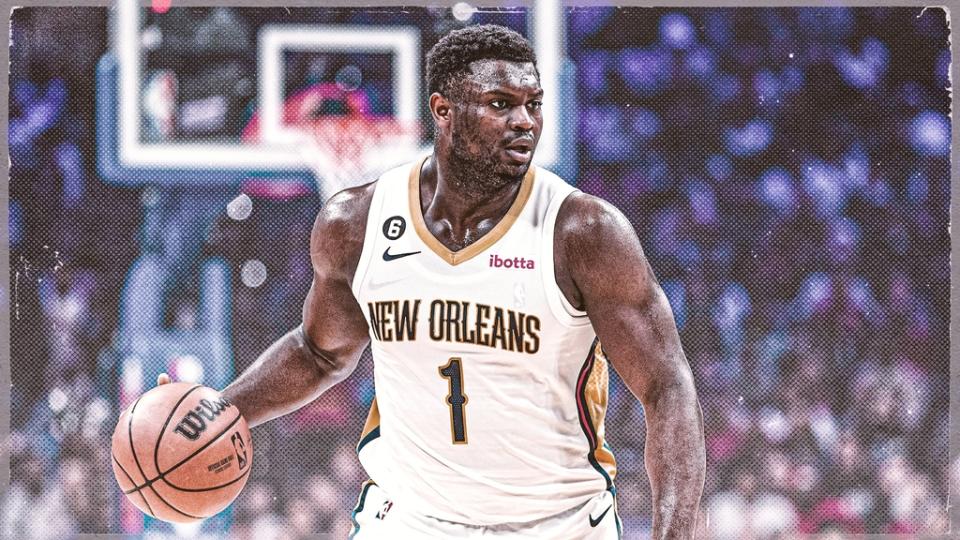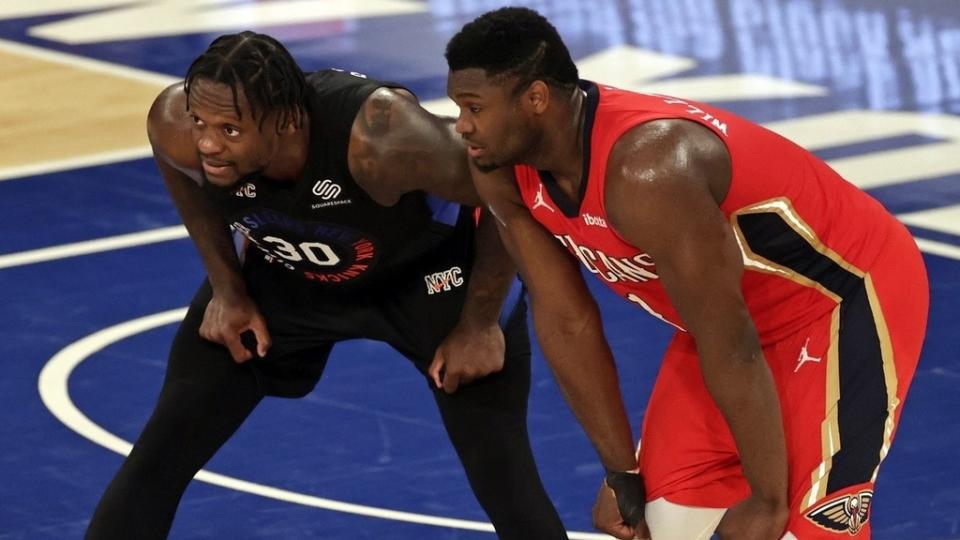Assessing Knicks' trade paths to New Orleans Pelicans star Zion Williamson

If you’re Knicks president Leon Rose, do you run it back next season?
Do you think RJ Barrett, Immanuel Quickley, Obi Toppin, Quentin Grimes, Mitchell Robinson, etc. can help you take a step forward? Are you willing to bet that internal improvement of those young players, and a full year of Josh Hart, can get you past the second round?
Or, do you trade some of those young players and draft picks for an established star? There could be several big names on the trade market this season. Karl-Anthony Towns, Damian Lillard, Joel Embiid, Jaylen Brown, etc.
Starting next Friday, you can include up to eight first-round picks in a trade. So you have the draft capital to make a competitive offer. And your young players – Barrett, Grimes, Quickley, Robinson – have improved their trade value since last summer. That gives you the opportunity to put together a compelling trade package for a top player.
With that in mind, we’ll look at the details of potential trades for top players over the next two weeks. We started with Towns and Bradley Beal (who looks to be headed to the Phoenix Suns), and we’ll look at Embiid, Lillard and others.
Today, we breakdown the math, pathways and impact of a Zion Williamson trade to the Knicks:
What would the Knicks need to give up?
Williamson will make $33.5 million next year. The Knicks would need to send out at least $26.6 million to satisfy league trade rules. They can do this in a number of ways. (Our scenarios include the assumption that New York declines Derrick Rose’s team option and picks up Miles McBride’s team option.)
If the package to New Orleans includes Evan Fournier, New York would need to send out an additional $8 million in the deal. A package including Fournier, Toppin and multiple first-round picks would work. This would allow the Pelicans to shed salary in 2023-24 and in 2024-25, when Fournier’s contract expires. If the Pelicans want Randle, the Knicks sending out $37 million in a package including Randle, Jericho Sims and multiple first-round picks would work.
What about Barrett? Barrett and Williamson have a close relationship. Based on that – and other on-court factors – you’d think the Knicks would not include Barrett in a trade for him.
Also worth noting: Grimes’ 2023-24 salary is $2.4 million and Quickley’s 2023-24 salary is $4 million. I assume New York would do everything it could to keep those two out of a deal. I also assume New Orleans would want Grimes and/or Quickley in a package for Williamson. From a salary perspective, it’s easy to include Grimes’ $2.4 million or Quickley’s $4 million into any deal that sends out a total of $26.6 million.
Of course, the Knicks can send out more than $26.6 million in a trade for Williamson. But we’d assume New Orleans wants to take back less salary to improve its flexibility and avoid any punitive measures in the new collective bargaining agreement.
And we’re not commenting on the wisdom of trading these players for Williamson; we’re just laying out the math involved in making the trade work.
Why would he be traded?
There has been frenzied speculation about New Orleans dealing with Williamson. The Athletic reported that the Pelicans want to move up in the 2023 draft to select guard Scoot Henderson. Williamson would, presumably, be a key part of a trade up to the top 3 in the draft.
Also, high-ranking members of the organization have been dismayed by recent off-court developments around Williamson, as other outlets have noted. The organization recently fired assistant coach Teresa Weatherspoon, a Naismith Hall of Famer, who was instrumental in the development of several young Pelicans, including Williamson. Those reading the tea leaves may surmise that Weatherspoon’s firing was related to the team’s issues with Williamson. (Knicks fans will remember Phil Jackson doing something similar amid organizational issues with Kristaps Porzingis.)
Still, if I had to guess, the Pelicans go into the 2023-24 season with Williamson on the roster.
Before Williamson suffered a season-ending hamstring injury on Jan. 2, the Pelicans were 10 games over .500. So there are tangible signs that a healthy Williamson will help New Orleans excel.
On the other hand, New Orleans is a luxury tax team at the moment. With big-money deals looming for Herb Jones and Brandon Ingram (among others), maybe the Pelicans feel they can get more production by sending Williamson elsewhere.

Injuries have limited Williamson to just 114 out of a possible 308 games in his career.
Would the Knicks have an interest in him? Any team would have to at least consider trading for Williamson. When healthy, he is one of the top young players in the league.
He’s averaging 25.8 points and 7.0 rebounds while shooting 60.5 percent in his four-year career.
Obviously, the risk you take on with Williamson is his injury history. He would presumably love the New York market. The Knicks were one of the teams people around Williamson hoped he’d land on before the draft. But the Knicks, to date, have been mostly risk averse during Leon Rose's tenure as team president. Trading multiple first-rounders and talented young players for Williamson would be a high-risk move.
Could the Knicks still add players after a Zion trade?
Yes. Let’s assume the Knicks stay below the apron of $169 million after this trade. This would leave them with access to the non-taxpayer mid-level exception ($12.2 million) which can be used on multiple players. They’d also have access to the $7.6 million bi-annual exception. So they would have tools to add other free agents after a Williamson trade. But they might be limited financially in future seasons if Williamson is on the roster with other high-salary players. The new CBA has punitive rules in place for teams that spend above a certain threshold, particularly once we get to the 2024-25 season.
Just food for thought as you consider what the Knicks should – or shouldn’t – do this offseason.

